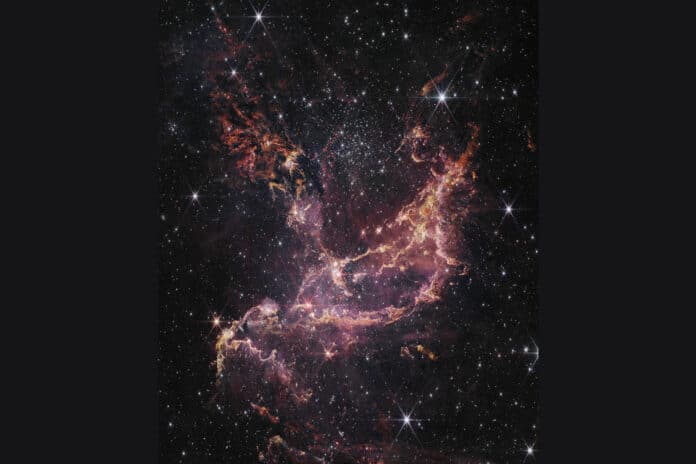Located about 200 light-years across the Small Magellanic Cloud (SMC), the NCG 346 is one of the most dynamic star-forming regions in nearby galaxies. The massive star cluster NGC 346 has long intrigued astronomers. Now, NASA’s James Webb Space Telescope uncovers the mystery of its star formation.
Compared to the Milky Way, the SMC has lower amounts of metals, which are elements heavier than hydrogen or helium. Scientists anticipated that there would be little dust and that it would be challenging to identify because most dust grains in space are made of metals. Webb’s most recent data shows the opposite.
Margaret Meixner, an astronomer at the Universities Space Research Association and principal investigator of the research team, said, “A galaxy during cosmic noon wouldn’t have one NGC 346 as the Small Magellanic Cloud does; it would have thousands. But even if NGC 346 is now the only massive cluster furiously forming stars in its galaxy, it offers us a great opportunity to probe conditions in place at cosmic noon.”
Scientists can determine whether the star formation process in the SMC differs from what we see in our Milky Way by looking at protostars that are still forming. Protostars with masses greater than 5 to 8 times that of the Sun were the main subject of earlier infrared observations of NGC 346.
Olivia Jones of the United Kingdom Astronomy Technology Centre, Royal Observatory Edinburgh, a co-investigator on the program, said, “With Webb, we can probe down to lighter-weight protostars, as small as one-tenth of our Sun, to see if their formation process is affected by the lower metal content.”
In Webb’s images, dust and gas from the surrounding molecular cloud can form ribbons when stars form and gather them. A disc of accretion receives the material and nourishes the core protostar. Within NGC 346, astronomers have discovered gas around protostars, but Webb’s near-infrared studies are the first to reveal dust in these discs.
Guido De Marchi of the European Space Agency, a co-investigator on the research team, said, “We see the building blocks, not only of stars but also potentially of planets. And since the Small Magellanic Cloud has a similar environment to galaxies during cosmic noon, it’s possible that rocky planets could have formed earlier in the universe than we might have thought.”
The team also has spectroscopic observations from Webb’s NIRSpec instrument that they are continuing to analyze. These data are expected to provide new insights into the material accreting onto individual protostars and the environment immediately surrounding the protostar.
These results are being presented on Jan. 11 in a press conference at the 241st meeting of the American Astronomical Society. The observations were obtained as part of program 1227.
